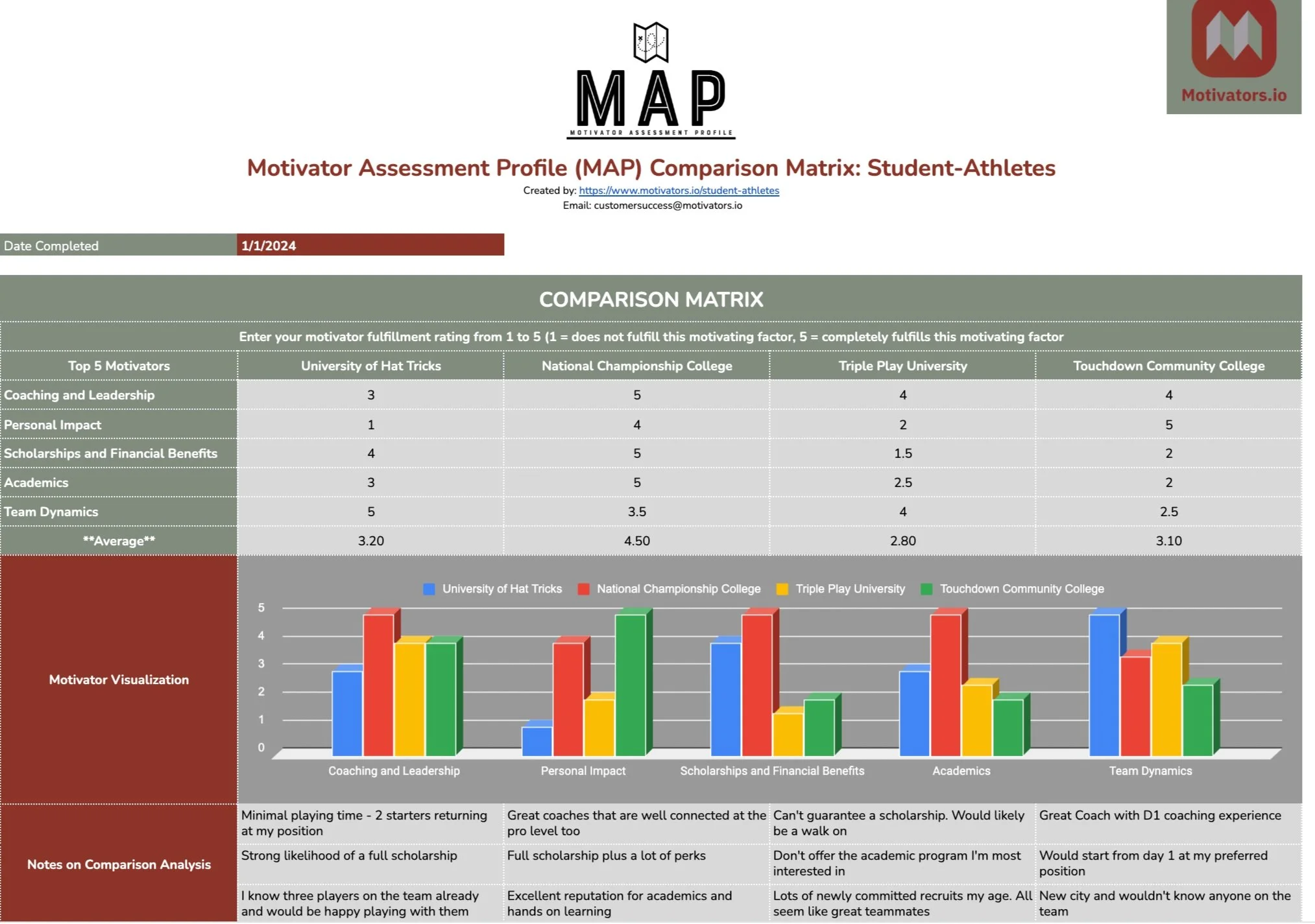Identify Your Top
Student-Athlete Motivators
Prioritize the Best Schools for You
The Motivator Assessment Profile (MAP) enables Student-Athletes, Recruiting Coaches, and Advisors to analyze student-athlete motivators, improve selection decisions, and reduce transfer risks
“With a brand-new roster, it's important for us to be able to analyze our players coming in so we can provide a great student-athlete experience.
I value the relationships that we have with all our players, but also wanted to understand more about what motivates them when it comes to being a part of our program. This personalized approach will build a cohesive and united team spirit.
The MAP is extremely valuable for our group!”
― Angel Whetstone, Head Coach, Women’s Basketball, Madison College
How it Works
-

1. Create Your Personalized MAP
Your student-athlete journey begins with an assessment to identify your top motivators. The assessment takes about 10-15 minutes to complete.
-

2. Self Reflection and Prioritization
Your personalized MAP Guidebook includes extensive student-athlete resources to help you prioritize and fulfill your top motivators at school.
-

3. Conversations and Action Plans
Shortlist or compare schools against your top motivators, or discuss your MAP insights with others, including coaches, advisors, and family.
Supported by research on student-athlete motivation, the Motivator Assessment Profile (MAP) analyzes 12 factors that influence student-athlete decisions to join, stay with, or leave a program:
-
The importance of education and learning within your academic discipline.
Examples include the reputation and ranking of the school, the quality of Professors, the potential for academic scholarships, and academic support services for student-athletes.
-
Access to resources and amenities that make you proud to be associated with your school and team.
Examples include investments in your home stadium or gym, athletic facilities, locker room, travel budget, and team perks.
-
Access to subject matter experts and resources to support your career growth and development.
Examples include learning and developing new skills, mentoring programs, networking events, and acquiring professional skills within your target job function or industry.
-
A Coach who consistently supports you as a student-athlete, both on and off the court.
Examples include a Coach who empowers you, provides performance feedback, enables you to develop new skills, and supports you in balancing your personal and academic responsibilities.
-
The importance of playing with and against student-athletes of a certain caliber.
Examples include the conference you play in, your team's ranking, and the level of exposure to media and fans.
-
The collection of values and beliefs that influence your behavior as a student-athlete, on and off campus.
Examples include your school's reputation, community involvement, and your influence on others.
-
The sentiment that you're being "taken care of" at school.
Examples include investments in your mental and physical health, support services, and well-being as a student-athlete.
-
The opportunity to directly impact the success of your team.
Examples include receiving regular and impactful playing time, contributing to the success of teammates, and feeling a sense of accomplishment in your performance.
-
Having access to the tools, resources, and expertise to maximize your skills and athletic potential.
Examples include personalized development plans, access to new technologies, and consistent feedback to support your development.
-
The opportunities to reduce your financial expenses, generate income, or monetize your influence.
Examples include athletic and academic scholarships, financial aid, name, image, and likeness (NIL) deals, and exposure to expand your influence and personal brand.
-
The importance of fulfilling your desired "student life" on and off campus.
Examples include your preferences for geographic location, food options, campus and class sizes, the social scene, and transportation methods.
-
An environment of respect, collaboration, and connection among teammates.
Examples include team-centric behaviors such as inclusion, friendship, psychological safety, mentorship, and alignment on expectations and measures of success.
MAP Insights: This spider chart compares the MAP results of a student-athlete recruit and the average MAP scores from current players on the team. In this example, Coaches and Team Recruiters should tailor their recruitment pitch to their team dynamics, health and wellness, and how the student-athlete can contribute to their culture and community.
For Recruiting Services, Agents, and Student-Athlete Advisors:
How the MAP Supports Your Professional Services
Personalize the Student-Athlete Experience
When you know what’s most important to your clients, you can tailor your advice based on their highest-scoring motivators. The net result? Every student-athlete easily connects the dots between their top motivators and the programs that are best suited to them.
Reduce Student-Athlete Transfer Risks
When you encourage student-athletes to discuss their top motivators with their Coaches and Advisors, you provide a safe space to address motivator-specific concerns. Meaningful student-athlete meetings lead to higher engagement, stronger relationships, and lower transfer portal risks.
Improve Your Decision Making and Recommendations
Whether you’re supporting high school students or athletes in the transfer portal, the MAP delivers key insights to support student-athlete decisions. Our MAP Guidebook includes self-reflection and discussion questions that Athletic Directors, Coaches, Recruiters, Parents, and Student-Athletes care about.
Implement Data-Driven Budgeting and Planning
It can be challenging for Recruiting Platforms, Experts, and Advisors to offer unique advisory solutions without credible data on student-athlete motivators. When you roll out the MAP at scale, you can acquire instant and filterable data, including detailed insights for all 66 motivator-specific questions.
Differentiate Your Value Proposition
No recruiting or advisory service can be everything to everyone. When you’re clear about your differentiators, you can target the student-athletes who will succeed in your program. Customize your MAP Guidebooks to support what’s most important to your athletes and clients.
Analyze Motivator Trends and Risks
Whether you’re exploring new partnerships, comparing motivators across different sports, or identifying new service offerings, the MAP Insights Dashboard converts student-athlete data into real-time motivator trends by sport, geography, and student-athlete demographics.
Reflect on Your Personalized MAP Guidebook
Overview: The Motivator Assessment Profile (MAP)
A map helps you to identify where you are and where you want to go; our MAP identifies the starting point and navigation steps to improve the student-athlete experience.
Assessment Process:
The Motivator Assessment Profile (MAP) is a 66-question assessment to identify and prioritize a student-athlete’s top motivators. The assessment takes approximately 10-15 minutes to complete.
Assessment User Experience:
The Motivator Assessment Profile (MAP) has an assessment satisfaction rating of 4.8 out of 5 stars from 320+ reviews on the CloudResearch survey platform.
Assessment Validity:
The Motivator Assessment Profile (MAP) was developed and validated through a research process led by Industrial/Organizational (I/O) Psychology and Behavioral Science teams.
This process adhered to the style guides for psychometric assessment and evaluation set forth by the British Psychological Society (BPS) and the American Psychological Association (APA), ensuring that the assessment tool conforms to rigorous scientific standards and principles.
MAP Guidebook Insights: Sample summary chart of a top-rated high school soccer player’s MAP results. In this example, Student-Athletes should shortlist teams and programs based on their potential impact on the team, academics, and the coaching and leadership support they’ll receive.
Create Your MAP Now
-

Student-Athletes ($25 USD)
INCLUDES:
- Access to complete your Motivator Assessment Profile (MAP)
- A personalized MAP Guidebook with motivator insights and student-athlete resources (15+ page summary)
- Scoring and stack ranking for all 12 motivators
- Detailed summaries and insights to support your top five motivators
- Personalized questions for self-reflection and career coaching
- Motivator-specific questions to discuss with your current or potential Coaches
-

Recruiting Services & Advisors ($25 USD)
INCLUDES:
- Bulk purchasing of MAP credits (minimum 5)
- White-labeled assessment link to send directly to your clients
- Real-time access to individual MAP results
- Personalized MAP Guidebooks for your Coaching or Professional Services practice (Brand, Logos, and Text)
- Option to purchase the MAP Insights Dashboard to analyze motivator trends across sports, division levels, and athlete demographics ($500 annually)
Frequently Asked Questions
-
Many traditional assessments label you as a generic “personality type” for life, rather than a continuum that can shift depending on the situation or context.
Our motivators change with our life and career priorities. A student-athlete's MAP results are a reflection of what motivates them TODAY.
There are no right or wrong answers for what motivates you. In fact, there are over 479 Million different ways that you could stack rank all 12 motivators!
-
When speaking with Coaches and Recruiters about their current student-athlete recruitment challenges, three themes emerged:
1. It’s difficult to accurately capture and respond to student-athlete motivators: Recruiters and Coaches conduct hundreds of student-athlete and parent meetings every year. It’s challenging to collect and summarize student-athlete insights at both the individual and team levels.
2. There’s inconsistency from one student-athlete's experience to the next: Some students are less engaged, others only tell Coaches and Recruiters what they believe they want to hear. Without transparency from both sides, student-athlete meetings tend to be surface-level rather than productive. Inconsistent recruitment processes can lead to poor team dynamics, regrettable scholarship decisions, and increased student-athlete transfers.
3. It's time consuming to personalize the recruitment process: Most programs follow a standard process for campus tours and email templates, rather than personalizing the process for each student-athlete. If Coaches and Recruiters had a better solution available, they'd strive to customize every student-athlete's recruitment experience.
Our Vision:
1. Empower Coaches and Recruiters to analyze student-athlete motivators, personalize the recruitment experience, and make better scholarship decisions.
2. Provide schools with better data and insights into what motivates their student-athletes, making it easier to support key themes across the team or athletic department. -
There are 66 motivator-specific questions, and the assessment takes about 10-15 minutes to complete.
You can also include demographic questions specific to your school and program.
-
Yes, and we encourage Recruitment Services and Advisors to take this approach.
When you leverage the MAP for multiple varsity teams, you can confidently invest in the programs and services that truly matter to student-athletes.
You can also filter your MAP insights by team and student-athlete demographics.
-
Yes, the Motivator Assessment Profile (MAP) was developed and validated through a research process led by Industrial/Organizational (IO) psychology and behavioral science teams.
This process adhered to the style guides for psychometric assessment and evaluation set forth by the British Psychological Society (BPS) and the American Psychological Association (APA), ensuring that the assessment tool conforms to rigorous scientific standards and principles.









